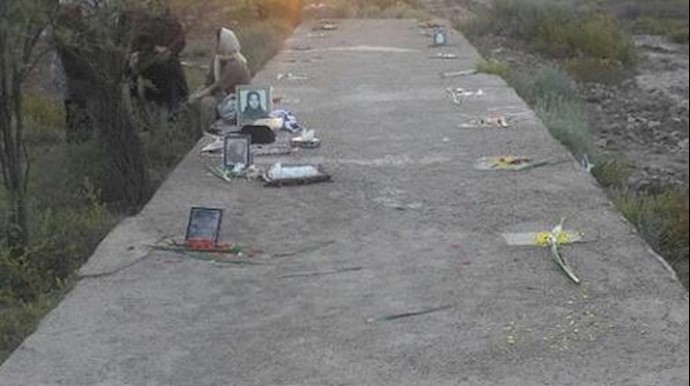Vital forensic evidence could be lost at site believed to contain remains of 44 executed political prisoners near southern city of Ahvaz
Authorities forbid commemoration of the dead and refer to gravesites as ‘damned land’
Amnesty International, 01 Jun 2017— The Iranian authorities’ building work at a mass grave site is set to destroy vital forensic evidence and derail efforts to secure justice for some of the mass prisoner killings that took place across the country in 1988, said Amnesty International and the NGO Justice for Iran today.
Photo and video evidence obtained by Justice for Iran and reviewed by Amnesty shows bulldozers working on a construction project directly alongside the mass grave site at Ahvaz in southern Iran, as well as piles of dirt and construction debris surrounding the grave.
Although the Iranian authorities have made no official announcements about the work, families have learned through a construction worker that the plan is to ultimately raze the concrete block (pictured) marking the grave site and build over the area. Work under way to widen the road running alongside the mass grave site would reportedly bring it very close to the site and the next phase of works would raze the concrete structure completely to clear the area for a “green space” or a commercial development.
The Ahvaz site – located on a barren piece of land two miles east of Behesht Abad Cemetery – is believed to contain the remains of at least 44 people who were among thousands of political prisoners killed in a wave of extrajudicial executions across Iran in the summer of 1988. The prisoners were rounded up and forcibly disappeared before being killed in secret, with their bodies then dumped into freshly dug trenches overnight. In Ahvaz, the authorities poured concrete over the mass grave immediately after the burials, apparently to prevent family members from digging up and recovering the bodies of their loved ones.
Mass graves are crime scenes that require professional forensic expertise to undertake exhumations and ensure preservation of evidence and accurate identification of bodies. By desecrating the site, the authorities will be destroying vital evidence that could one day be used to shed light on the number and identity of those killed in state custody.
Magdalena Mughrabi Amnesty International’s Middle East and North Africa Deputy Director, said:
“By attempting to destroy the mass grave in Ahvaz, the Iranian authorities appear to be embarking on a sinister and deliberate effort to destroy crucial evidence of their past crimes and deprive the families of the victims of the 1988 mass prisoner killings of their right to truth, justice and reparation. This is a shocking assault on justice that must be stopped immediately.
“Instead of trying to erase the memory of those killed and obstruct justice, the Iranian authorities must ensure that the mass gravesites of the 1988 mass killings are preserved and protected until proper, independent investigations can be carried out. Families have the right to know what happened to their loved ones and bury them in dignity.”
Shadi Sadr, the Executive Director of Justice for Iran, said:
“For years the authorities have inflicted unbearable suffering on the families of the victims of the 1988 extrajudicial executions. They have denied them the right to give their loved ones a dignified burial and forced them to walk through piles of rubbish to visit their dead. Now they are planning to destroy their final resting place and trying to obliterate their memory from history.”
The 1988 prison massacres
This is not the only large-scale grave from the mass killings of 1988 at risk of destruction. Justice for Iran has learned of apparent efforts to tamper with another site in the north-eastern city of Mashhad, in Khorasan Razavi province, where up to 170 political prisoners are believed to be buried. Bereaved families who visited the site on the edge of Mashhad’s Behesht Reza Cemetery in March discovered that the previously flat area had been covered with soil to create a raised mound over the grave. Although the reasons for this remain unclear, there are concerns the authorities are attempting to eliminate all trace of their mass extrajudicial killings.
Over the past three decades, the authorities’ disrespectful treatment of the victims’ remains has compounded the suffering of bereaved family members. The authorities regularly insult the dead and torment their families by referring to mass graves as la’nat abad (“the damned land”) and have repeatedly told families their loved ones were “outlaws” who didn’t deserve a proper burial or tombstone. Families are forbidden from holding commemorative gatherings or decorating mass gravesites with memorial messages.
The mass extrajudicial executions of political prisoners in 1988, known as the “prison massacres”, beganin July 1988. Political prisoners from across the country were rounded up and held incommunicado for months, as reports circulated among relatives that prisoners were being executed in groups and buried in unmarked or mass graves. Families were then verbally told their relatives had been killed but the bodies were not returned and most locations of burial sites were kept secret.
The vast majority of those killed had already spent years in prison, often for peacefully exercising their rights by distributing newspapers and leaflets, taking part in peaceful anti-government demonstrations, or having real or perceived affiliations with political opposition groups. Some had already completed their sentences but had not been released because they refused to “repent”. To date, no Iranian officials have been investigated and brought to justice for the killings and some of the alleged perpetrators continue to hold political office or other influential positions, including in the judiciary.








